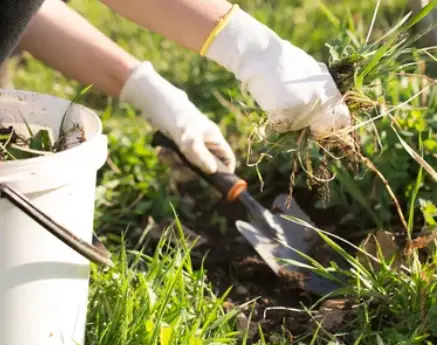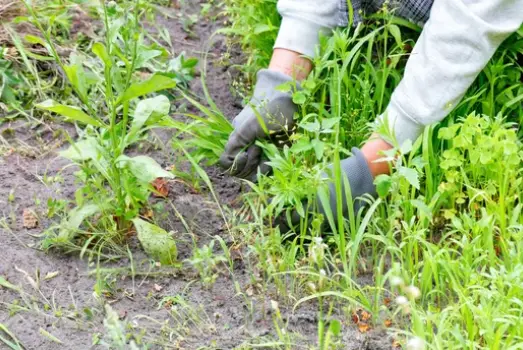How to Keep Weeds Out of The Garden? Gardening can be a very rewarding activity that allows you to enjoy what you eat and the beauty of nature.
However, one of the biggest challenges faced by gardeners is weed control.
Weeds can quickly overtake your garden, choking out your carefully cultivated plants and robbing them of vital nutrients.
To maintain a healthy and productive garden, it is essential to keep weeds under control.
In this post, we will explore various methods of weed prevention and control, including both chemical and manual options, so that you can keep your garden weed-free and thriving.
How to Keep Weeds Out of The Garden

Keeping weeds out of your garden can be achieved through a combination of preventive measures and control methods. Here is a summary of some effective strategies for keeping weeds out of your garden:
- Preventive measures:
- Mulch the garden beds to suppress weed growth
- Proper spacing and pruning to prevent overcrowding
- Use cover crops to add nutrients and suppress weeds
- Hand-pull young weeds regularly before they mature and spread
- Plant weed-resistant varieties of plants
- Chemical control:
- Use herbicides, either synthetic or organic, as a last resort
- Carefully follow the instructions on the label to ensure safe and effective use
- Manual control:
- Use hand weeding, hoeing, cultivation, or mowing to physically remove weeds
- Regularly inspect your garden and remove any weeds as soon as they are spotted
Understanding Weeds

Before discussing how to keep weeds out of the garden, it is important to understand what weeds are and the negative impact they can have on your plants.
Weeds are any plants that grow where they are not wanted or needed, competing with desirable plants for resources such as water, nutrients, and sunlight. Weeds can grow rapidly and spread quickly, often overtaking garden beds and even entire landscapes.
There are many different types of weeds that can invade your garden, including broadleaf weeds like dandelions and thistles, grassy weeds like crabgrass and Bermuda grass, and sedges like nutsedge.
Weeds not only compete with garden plants for resources, but they can also attract pests and diseases, reducing the overall health and productivity of your garden.
It is important to identify and understand the types of weeds in your garden so that you can choose the most effective methods for prevention and control.
Understanding the negative effects of weeds on your garden, you can take proactive measures to keep them at bay and ensure the health and vitality of your plants.
Preventing Weeds

Preventing weeds from taking over your garden is an essential step in weed control. Here are some methods you can use to prevent weeds from growing:
- Mulching: Applying a layer of mulch around plants and garden beds can help prevent weed growth by blocking sunlight and inhibiting weed seed germination.
- Landscape Fabric: Placing landscape fabric under mulch or gravel can further reduce weed growth by preventing weed seeds from making contact with the soil.
- Proper Spacing and Pruning: Proper spacing and pruning of plants can help discourage weed growth by providing adequate sunlight and air circulation.
- Cover Crops: Planting cover crops such as clover or winter rye can help suppress weed growth by outcompeting weeds for resources.
- Hand-Pulling: Regularly hand-pulling weeds as soon as they appear can help prevent them from taking root and spreading.
Chemical Control

Chemical control is another method that can be used to control weeds in your garden. Here are some chemical control methods:
- Herbicides: Herbicides are chemical substances that are specifically designed to kill weeds. There are two main types of herbicides: pre-emergent herbicides and post-emergent herbicides.
- Pre-emergent herbicides are applied to soil before weed seeds have germinated. They prevent weed seeds from germinating and growing.
- Post-emergent herbicides are applied to weeds that have already emerged. They work by killing the weeds through absorption by the leaves, stems, and roots.
It is important to carefully read and follow the instructions on the herbicide label, as improper use can be harmful to your plants and the environment.
- Organic Herbicides: Organic herbicides are made from natural ingredients such as vinegar, citrus oil, and clove oil. They can be effective in controlling some types of weeds, but may not be as effective as synthetic herbicides.
- Glyphosate: Glyphosate is a synthetic herbicide that is widely used for weed control. It is a non-selective herbicide, meaning it can kill both weeds and desirable plants. It is important to use glyphosate carefully and follow instructions, as it can be harmful to humans and the environment.
Manual Control

Manual control is another effective method to control weeds in your garden. Here are some manual control methods:
- Hand Weeding: Hand weeding involves pulling weeds by hand, usually using a garden trowel or hoe. This is best done when the soil is moist, as it is easier to pull the weeds out with their roots intact. It is important to remove the entire weed, including the roots, to prevent regrowth.
- Hoeing: Hoeing involves cutting the tops of weeds off with a sharp hoe just above the soil line. This can be an effective method for removing large patches of weeds quickly, but it may not be as effective as hand weeding for removing weeds with deep roots.
- Cultivation: Cultivating the soil between plants with a cultivator or hoe can help prevent weed growth by disturbing the soil surface and uprooting young weed seedlings.
- Mowing: Mowing can be an effective method for controlling weeds in areas with grassy weeds like Bermuda grass. Regularly mowing the grass can prevent the weeds from producing seeds and spreading.
Manual control methods require more physical effort than chemical control methods but can be effective and environmentally friendly.
They are best suited for small garden areas or areas where weeds are sparse. Regularly practicing manual control can help prevent weed growth and keep your garden healthy.
Maintenance and Follow-Up
Once you have implemented weed prevention and control measures in your garden, it is important to maintain and follow up on them regularly to ensure their effectiveness. Here are some tips for maintaining and following up on weed control measures:
- Regular Inspections: Regularly inspect your garden for weed growth, paying close attention to areas where weeds are likely to grow, such as edges and corners. As soon as you spot weeds, remove them immediately to prevent them from spreading.
- Watering: Proper watering can help prevent weed growth by encouraging your plants to establish deep roots and compete with weeds for resources. However, it is important not to overwater, as this can create an ideal environment for weed growth.
- Fertilizing: Regular fertilizing can help keep your plants healthy and strong, enabling them to better compete with weeds for resources.
- Mulching: Mulch breaks down over time, so it is important to add new mulch regularly to maintain its effectiveness in preventing weed growth.
- Reapplication: For chemical and organic herbicides, it is important to follow the instructions on the label for reapplication. Reapplication may be necessary to ensure continued control of weeds.
Conclusion
Weeds can be a persistent and frustrating problem in any garden, but with the right prevention and control methods, you can keep them at bay and maintain a healthy garden.
Understanding the types of weeds that grow in your area and implementing preventive measures such as mulching, proper spacing and pruning, cover crops, and hand-pulling, can reduce weed growth and keep your garden healthy.
Also, chemical and manual control methods such as herbicides, hand weeding, hoeing, cultivation, and mowing can be effective for controlling weed growth.
To maintain the effectiveness of these methods, it is important to regularly inspect and maintain your garden, paying attention to areas where weeds are likely to grow, and reapplying control measures as needed.
With these strategies in place, you can keep your garden beautiful and weed-free.




